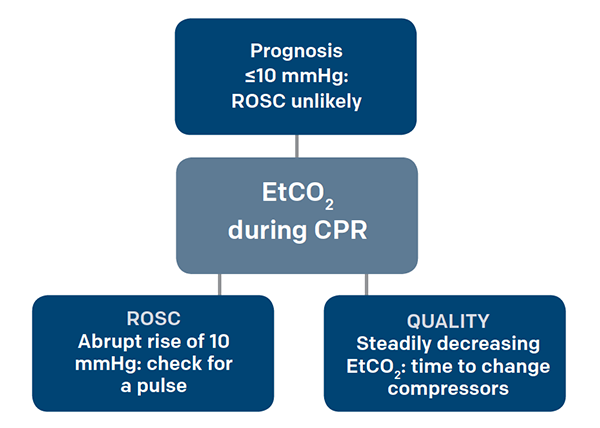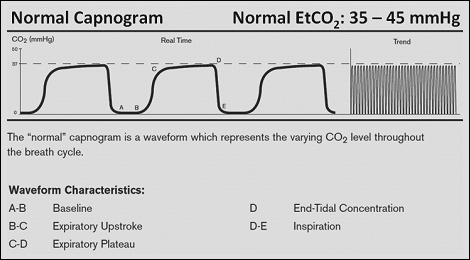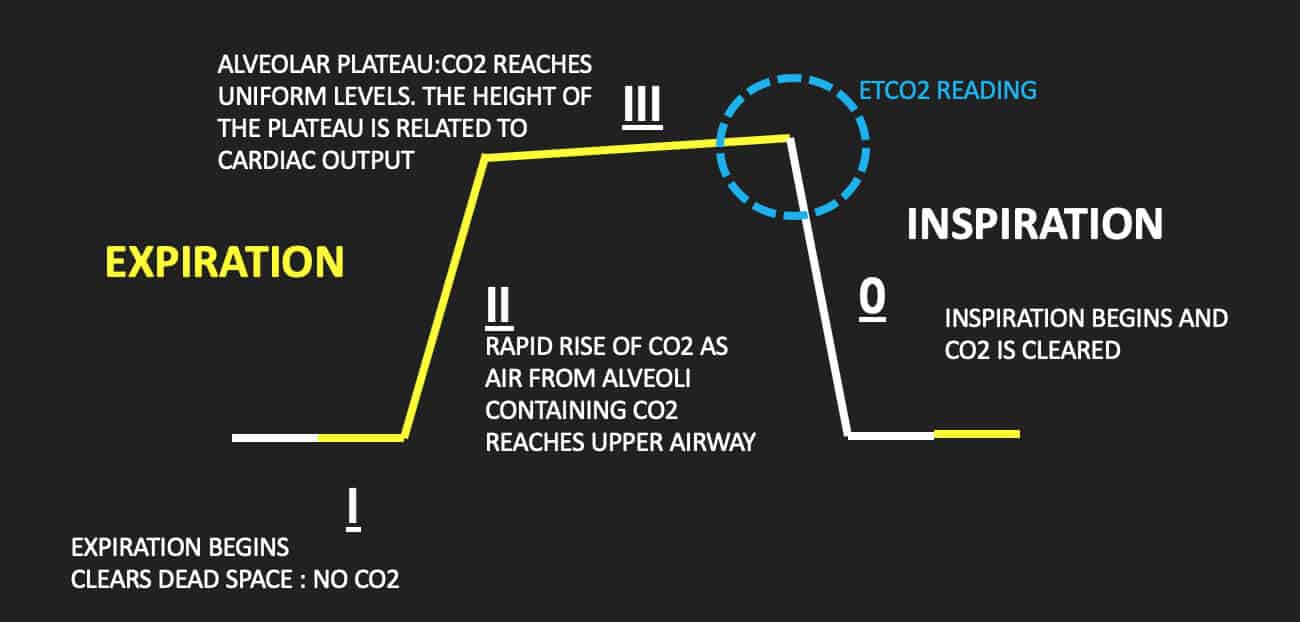end tidal co2 range in cardiac arrest
MmHg Relate to the air we breath. Literature search was performed using Medline and EMBASE.

Potential Applications Of Capnography In The Prehospital Setting Journal Of Paramedic Practice
ETCO220mmHg averaged during the first 10 min of recorded CPR is associated with 1 compliance with AHA CC depth quality targets and 2 survival to hospital.

. This cardiac arrest was witnessed and immediate cardiopulmonary resuscitation efforts were initiated by a bystander and a trained first responder nearby. The number is called capnometry which is the partial pressure of CO 2 detected at the end of exhalation ranging between 35 - 45 mm Hg or 40 57 kPa. AHA recommends titrating chest compressions CC to achieve end-tidal carbon dioxide ETCO220mmHg based on laboratory adult and very limited pediatric IHCA data.
CO2 will decrease prior to a cardiac arrest in patients that are intubated in an intensive care setting. Poppe M Stratil P Clodi C et al. Total pressure of a gas is the sum of the partial pressures of the gas Expired CO2 measured PetCO2 mmHg in waveform Percentage Normal Levels PaO2 85-100mmHg PaCO2 35-45mmHg Percentage vs.
End-tidal carbon dioxide monitoring in cardiac arrest. Throughout the resuscitation end-tidal CO 2 was consistently in the 28-36 mmHg range during VFCPR. After 20 minutes of CPR death occurs if ETCO2 is consistently below 10 mmHg with 100 sensitivity and specificity 15.
CO2 will decrease prior to a cardiac arrest in patients that are intubated in an intensive care setting. In contrast survivors ETCO2 just before restoration of circulation averaged 31 - 53 mm Hg range 16 to 35 mm Hg P 0001. Because it splits into CO2 and H20 So if rises after NaHCO3 do not.
Goals of this investigation. End-tidal carbon dioxide cannot be used to rule out severe injury in patients meeting the criteria. End tidal CO2 in cardiac arrest.
Predicting likelihood of return of spontaneous circulation ROSC in that a persistently low ETCO2 tends to predict death whereas a high or rising ETCO2 is associated with a higher chance of ROSC. The purpose of this systematic review is to evaluate the prognostic value of ETCO2 during cardiac arrest and to explore whether ETCO2 values could be utilised as a tool to predict the outcome of resuscitation. Initial end-tidal carbon dioxide as a predictive factor for return of spontaneous circulation in nonshockable out-of-hospital cardiac arrest patients.
To assess the prognostic value of initial end-tidal CO2 pressures PETCO2 during CPR in patients with out-of-hospital cardiac arrest OHCA. BackgroundPhysiology 2 Monitoring end-tidal CO 2 ET-CO 2 provides instantaneous information about ventilation how effectively CO. Measuring end-tidal CO2 in cardiac arrest patients is helpful for.
End-tidal carbon dioxide monitoring in cardiac arrest. An increase in etCO2 by 5 appears to have reasonable sensitivity 71-91 and specificity 94-100 for fluid responsiveness in two studies of patients breathing passively on the ventilator. After 20 minutes of advanced cardiac life support ETCO2 averaged 39 - 28 mm Hg range 0 to 12 mm Hg in patients in whom the theoretical decision was made to cease field resuscitation.
Using an ETCO2 of 10 mm Hg or less as a theoretical. Does the end-tidal carbon dioxide EtCO2 concentration have prognostic value. Only after the end tidal CO2 is optimized obtain an ABGVBG to verify that the pCO2 is within the target range 35-45 mm Hg or 45-6 kPa.
Because impaired circulation during arrest causes CO2 to build up in the bloodstream the initial ETCO2 reading may initially be higher than the normal 35-45 mm Hg range as it gets washed out of. End-tidal carbon dioxide monitoring in cardiac arrest Acad Emerg Med. Immediately after intubation adjust the minute ventilation to achieve an end-tidal CO2 of 30-35 mm.
End tidal carbon dioxide CO2 correlates with cardiac output during cardiopulmonary resuscitation in cardiac arrest patients. During cardiopulmonary reanimation CPR the. The majority of study participants presented with only one type of shock with only 13 patients 126 having a diagnosis of two types of shock on arrival.
In clinical observational studies mean ETCO 2 levels in patients with ROSC are higher. Adjust the ventilator as needed. Pierre Kory Laura OBrien RN CNS.
MEASURING END-TIDAL CO 2 LEVELS DURING CARDIAC ARREST Presentation for MSBI Nurses Prepared by Dr. An accurate early predictor of the outcome of resuscitation is needed. Measurement of end-tidal expiratory pressure of carbon dioxide ETCO 2 using capnography provides a noninvasive estimate of cardiac output and organ perfusion during cardiac arrest and can therefore be used to monitor the quality of CPR and predict return of spontaneous circulation ROSC.
Endotracheal intubation was carried out in 48 n 49 of the studied sample. In recent years there has been an increased interest in the use of capnometry the noninvasive continuous measurement of partial pressure of end-tidal carbon dioxide petCO2 in expired air. Increasing CO2 during CPR can also indicate the return of spontaneous circulation.
Animal studies have shown that end-tidal carbon dioxide EtCO 2 detected during CPR is primarily dependent on pulmonary blood flow and is therefore a potential surrogate marker of perfusion during CPR46 However there. A prospective observational study using a convenience sample. Studies have shown that in patients who had ETCO2 of 10 mmHg or less cardiac arrest was associated with death 13 14.
End tidal carbon dioxide CO2 correlates with cardiac output during cardiopulmonary resuscitation in cardiac arrest patients. Since pCO2 is always above the end-tidal CO2 this will generally put the pCO2 into a safe range. 11172009 4 Measuring End Tidal CO2 Daltons Law.
Outcomes23 During cardiac arrest CPR functions to deliver substrate to vital organs. The first aim of the study was to investigate whether arteriolealveolar carbon dioxide difference AaDCO2 which is calculated using blood gas parameters and end-tidal carbon dioxide EtCO2 which is measured by capnography could be used as prognostic markers for patients with cardiac arrest in which ROSC is provided. End-tidal CO2 may be useful here as an easily and immediately measurable index of changes in cardiac output.
The use of end-tidal carbon dioxide ETCO2 measurement to guide management of cardiac arrest. End tidal CO 2 monitoring is represented as a number and a graph on a monitor. Primary service area of an advanced life support ALS ambulance service including a city with a population of 70745 and the.
Increasing CO2 during CPR can also indicate the return of spontaneous circulation. PetCO2monitoring has been useful in determining the effectiveness of cardiopulmonary resuscitation. The mean end tidal CO 2 on arrival in the department was 2907 mmHg SD 996.
78 Nitrogen 21 Oxygen 1 CO2 and other gases Exhaled gases.

End Tidal Capnography Can Be Useful For Detecting Diabetic Ketoacidosis Monitoring Copd Page 2 Of 4 Acep Now Page 2

Capnography Provides Bigger Physiological Picture To Maximize Patient Care Jems Ems Emergency Medical Services Training Paramedic Emt News

Waveform Capnography In The Intubated Patient Emcrit Project

Use End Tidal Capnography For Placing Orogastric Nasogastric Tubes And Cpr Acep Now

Average Etco2 Kpa During Cpr In Patients With Or Without Rosc Download Scientific Diagram
Emdocs Net Emergency Medicine Educationcapnography In The Ed Emdocs Net Emergency Medicine Education

Sar Helicopter Paramedic Practice Etco2 Measuring To Assist With Cpr Attempts Journal Of Paramedic Practice

Waveform Capnography In The Intubated Patient Emcrit Project

Basic Capnography Interpretation Nuem Blog

Capnogram R Series Defibrillator Zoll Medical Uk

Waveform Capnography In The Intubated Patient Emcrit Project

3 Waveform Capnography Showing Changes In The End Tidal Carbon Dioxide Download Scientific Diagram

Capnography Provides Bigger Physiological Picture To Maximize Patient Care Jems Ems Emergency Medical Services Training Paramedic Emt News
End Tidal Co2 Monitoring In The Pre Hospital Environment More Than Just Endotracheal Tube Placement Confirmation Journal Of Paramedic Practice

Reversible Causes Of Low Etco2 In Cpr Criticalcarenow

Waveform Capnography In The Intubated Patient Emcrit Project

Etco2 Valuable Vital Sign To Assess Perfusion The Airway Jedi

